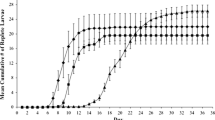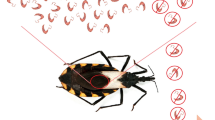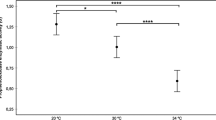Abstract
Trypanosoma rangeli is a protozoan parasite that infects mammals and triatomines, causing different levels of pathogenicity in its invertebrate vectors, particularly those from the genus Rhodnius. We have recently shown that temperature can modulate T. rangeli growth during in vitro culture, as well as its in vivo pathogenicity to R. prolixus. In the present study, we investigated colonization of R. prolixus by T. rangeli and assessed the role of temperature and vector nutrition on parasite development and multiplication. We infected nymphs and either assessed parasite density in the first hours after the ingestion of the infected blood or maintained the nymphs for up to 60 days at different temperatures (21, 24, 27, and 30 °C) and under different blood-feeding schedules (either every 15 days, or on day 30 post infection only), with parasite development and multiplication measured on days 15, 30, and 60 post infection. In the first hours after ingesting infected blood, epimastigogenesis not only occurred in the anterior midgut, but a stable parasite population also established in this intestinal region. T. rangeli subsequently colonized all intestinal regions examined, but with fewer parasites being found in the rectum. The number of parasites was only affected by higher temperatures (27 and 30 °C) during the beginning of the infection (15 days post infection). Nutritional status of the vector also had a significant effect on parasite development, as reduced blood-feeding decreased infection rates by approximately 30%.






Similar content being viewed by others
References
Añez N (1983) Studies on Trypanosoma rangeli Tejera, 1920. V. Developmental pattern in the alimentary canal of Rhodnius prolixus. Mem Inst Oswaldo Cruz 78:183–191
Añez N, Nieves E, Cazorla D (1987) Studies on Trypanosoma rangeli Tejera, 1920. IX. Course of infection in different stages of Rhodnius prolixus. Mem Inst Oswaldo Cruz 82:1–6
Azambuja P, Guimarães J, Garcia E (1983) Haemolytic factor from the crop of Rhodnius prolixus: evidence and partial characterization. J Insect Physiol 29:833–837
Azambuja P, Feder D, Garcia E (2004) Isolation of Serratia marcescens in the midgut of Rhodnius prolixus: impact on the establishment of the parasite Trypanosoma cruzi in the vector. Exp Parasitol 107:89–96
Billingsley PF, Downe AER (1985) Cellular localization of aminopeptidase in the midgut of Rhodnius prolixus Stal (Hemiptera: Reduviidae) during blood digestion. Cell Tissue Res 241:421–428
Billingsley PF, Downe AER (1988) Ultrastructural localization of cathepsin B in the midgut of Rhodnius prolixus Stal (Hemiptera: Reduviidae) during blood digestion. Int J Insect Morphol Embryol 17:295–302
Brener Z (1962) Therapeutic activity and criterion of cure on mice experimentally infected with Trypanosoma cruzi. Rev Inst Med Trop Sao Paulo 4:389–396
Carcavallo RU, Silva RM, Otero AMA, Tonn RJ (1975) Infección natural de Rhodnius robustus Larrouse y Rhodnius pictipes Stal por T. cruzi y T. rangeli en Venezuela. Bol Dir Malariol Saneamiento Ambient 15:117–120
Clarke A, Fraser KPP (2004) Why does metabolism scale with temperature? Funct Ecol 18:243–251
Cuba Cuba CA (1998) Review of biological and diagnostic aspects of Trypanosoma (Herpetosoma) rangeli. Rev Soc Bras Med Trop 31:207–220
D’Alessandro A, Mandrel S (1969) Natural infections and behavior of Trypanosoma rangeli and Trypanosoma cruzi in the vector Rhodnius prolixus in Colombia. J Parasitol 55:846–852
D’Alessandro A, Saravia NG (1999) Trypanosoma rangeli. In: Gilles HM (ed) Protozoal disease. University Press, Oxford, pp 398–412
Dias FA, Guerra B, Vieira LR, Perdomo HD, Gandara ACP, do Amaral RJV, Vollu RE, Gomes SAO, Lara FA, Sorgine MHF, Medei E, Oliveira PL, Salmon D (2015) Monitoring of the parasite load in the digestive tract of Rhodnius prolixus by combined qPCR analysis and imaging techniques provides new insights into the trypanosome life cycle. PLoS Negl Trop Dis 9(10):e0004186. https://doi.org/10.1371/journal.pntd.0004186
Elliot SL, Rodrigues JO, Lorenzo MG, Martins-Filho OA, Guarneri AA (2015) Trypanosoma cruzi, etiological agent of Chagas disease, is virulent to its triatomine vector Rhodnius prolixus in a temperature-dependent manner. PLoS Negl Trop Dis 9:e0003646. https://doi.org/10.1371/journal.pntd.0003646
Ferreira LL, Lorenzo MG, Elliot SL, Guarneri AA (2010) A standardizable protocol for infection of Rhodnius prolixus with Trypanosoma rangeli, which mimics natural infections and reveals physiological effects of infection upon the insect. J Invertebr Pathol 105:91–97
Ferreira LL, Pereira M, Guarneri AA (2015) Revisiting Trypanosoma rangeli transmission involving susceptible and non-susceptible hosts. PLoS One 10(10):e0140575. https://doi.org/10.1371/journal.pone.0140575
Ferreira RC, Kessler RL, Lorenzo MG, Paim RMM, Ferreira LL, Probst CM, Alves-Silva J, Guarneri AA (2016) Colonization of Rhodnius prolixus gut by Trypanosoma cruzi involves an extensive parasite killing. Parasitology 143:434–443
Guarneri AA, Lorenzo MG (2017) Triatomine physiology in the context of trypanosome infection. J Insect Physiol 97:66–76
Guarneri AA, Lazzari C, Xavier AAP, Diotaiuti L, Lorenzo MG (2003) The effect of temperature on the behaviour and development of Triatoma brasiliensis. Physiol Entomol 28:185–191
Hecker H, Schwarzenbach M, Rudin W (1990) Development and interactions of Trypanosoma rangeli in and with the reduviid bug Rhodnius prolixus. Parasitol Res 76:311–318
Hoare CA, Wallace FG (1966) Developmental stages of trypanosomatid flagellates: a new terminology. Nature 212:1385–1386
Koerich L, Emmanuelle-Machado P, Santos K, Grisard EC, Steindel M (2002) Differentiation of Trypanosoma rangeli: high production of infective trypomastigote forms in vitro. Parasitol Res 88:21–25
Kollien AH, Schmidt J, Schaub GA (1998) Modes of association of Trypanosoma cruzi with the intestinal tract of the vector Triatoma infestans. Acta Trop 70:127–141
Maia da Silva F, Junqueira ACV, Campaner M, Rodrigues AC, Crisante G, Ramirez LE, Caballero ZCE, Monteiro FA, Añez N, Teixeira MMG (2007) Comparative phylogeography of Trypanosoma rangeli and Rhodnius (Hemiptera: Reduviidae) supports a long coexistence of parasite lineages and their sympatric vectors. Mol Ecol 16:3361–3373
Marquez DDS, Rodrigues-Ottaiano C, Oliveira RM, Pedrosa AL, Cabrine-Santos M, Lages-Silva E, Ramírez LE (2006) Susceptibility of different triatomine species to Trypanosoma rangeli experimental infection. Vector Borne Zoonotic Dis 6:50–56
Mello C, Azambuja P, Garcia E, Ratcliffe N (1996) Differential in vitro and in vivo behavior of three strains of Trypanosoma cruzi in the gut and hemolymph of Rhodnius prolixus. Exp Parasitol 82:112–121
Pereira M, Andrade A, Ribeiro J (1981) Lectins of distinct specificity in Rhodnius prolixus interact selectively with Trypanosoma cruzi. Science 211:597–600
Ramirez LE, Lages-Silva E, Alvarenga-Franco F, Matos A, Vargas N, Fernandes O, Zingales B (2002) High prevalence of Trypanosoma rangeli and Trypanosoma cruzi in opossums and triatomids in a formerly-endemic area of Chagas disease in Southeast Brazil. Acta Trop 84:189–198
Rodrigues JDO, Lorenzo MG, Martins-Filho OA, Elliot SL, Guarneri AA (2016) Temperature and parasite life-history are important modulators of the outcome of Trypanosoma rangeli–Rhodnius prolixus interactions. Parasitology 143:1459–1468
Schaub GA (1989) Trypanosoma cruzi: quantitative studies of development of two strains in small intestine and rectum of the vector Triatoma infestans. Exp Parasitol 68:260–273
Schmidt J, Kleffmann T, Schaub GA (1998) Hydrophobic attachment of Trypanosoma cruzi to a superficial layer of the rectal cuticle in the bug Triatoma infestans. Parasitol Res 84:527–536
Schottelius J (1987) Neuraminidase fluorescence test for the differentiation of Trypanosoma cruzi and Trypanosoma rangeli. Trop Med Parasitol 38:323–327
Sherlock I (1979) Epidemiologia. In: Trypanosoma cruzi e Doença de Chagas. Guanabara Koogan, Rio de Janeiro, pp 89–151
Sternberg ED, Thomas MB (2014) Local adaptation to temperature and the implications for vector-borne diseases. Trends Parasitol 30:115–122
Thomas MB, Blanford S (2003) Thermal biology in insect-parasite interactions. Trends Ecol Evol 18:344–350
Tobie EJ (1965) Biological factors influencing transmission of Trypanosoma rangeli by Rhodnius prolixus. J Parasitol 51:837–841
Vallejo GA, Suárez J, Olaya JL, Gutiérrez SA, Carranza JC (2015) Trypanosoma rangeli: un protozoo infectivo y no patógeno para el humano que contribuye al entendimiento de la transmisión vectorial y la infección por Trypanosoma cruzi, agente causal de la enfermedad de Chagas. Rev Acad Colomb Cienc Exact Fis Nat 39:111–122
Funding
AAG was supported by CNPq productivity grants. This work received financial support from Fundação de Amparo à Pesquisa do Estado de Minas Gerais (FAPEMIG), Conselho Nacional de Desenvolvimento Científico e Tecnológico (CNPq), Instituto Nacional de Ciência e Tecnologia em Entomologia Molecular (INCT-EM/CNPq), and Programa Estratégico de Apoio a Pesquisa em Saúde (PAPES VI/FIOCRUZ).
Author information
Authors and Affiliations
Corresponding author
Ethics declarations
All protocols involving animals followed established procedures of Fiocruz and were approved by the Ethics Committee on Animal Use (CEUA-FIOCRUZ) under the license number LW 61/12.
Rights and permissions
About this article
Cite this article
Ferreira, R.C., Teixeira, C.F., de Sousa, V.F.A. et al. Effect of temperature and vector nutrition on the development and multiplication of Trypanosoma rangeli in Rhodnius prolixus. Parasitol Res 117, 1737–1744 (2018). https://doi.org/10.1007/s00436-018-5854-2
Received:
Accepted:
Published:
Issue Date:
DOI: https://doi.org/10.1007/s00436-018-5854-2




